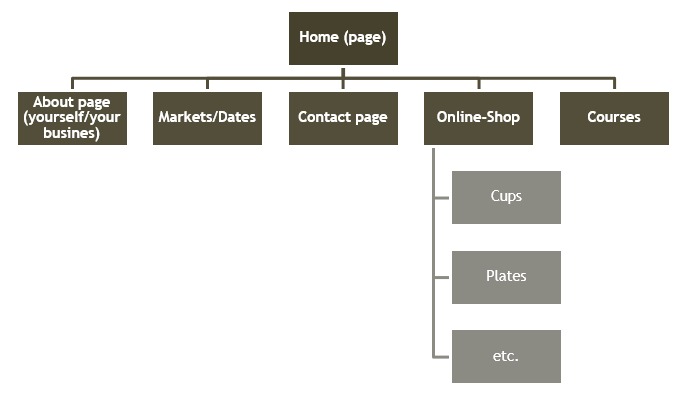
An online marketplace where retailers offer handicrafts. Great choice especially for beginning small producers and those who do not want to waste time preparing their own e-shop or website. Creating a profile takes a few minutes, after confirming the registration it is possible to start creating your own product page. It is usually possible to create a blog on the platform, join discussions or clubs with other users.
Low costs
Low time requirements
Speed of connection to the platform and start of sales or presentation
Preset templates to fill
The possibility of comparing competing manufacturers
Discussion forums with people from the same field
Limited possibility of custom setting of the eshop (it is necessary to follow the preset templates)
For free (Low)
Fot customers who want local and handmade products
It may be “For free”, but on some platforms they may have a fee (“Low”)
E-shops are an essential part of today’s sales channels. In the case of larger production of products, it is advisable to set up an e-shop (especially in the time of the covid). The e-shop can exist separately with the addition of information about the manufacturer (manufacturer’s presentation) or it can be part of the manufacturer’s website. Before its implementation, it is necessary to determine who will take care of its operation (the manufacturer, employee, external expert), how the payment and transport conditions will be set.
Space for the development of own creativity and arrangement of the e-shop according to own ideas and wishes
Thanks to the available templates relatively easy to prepare on own without greater knowledge of programming
Higher costs (purchase of a domain, preparation of the e-shop, administration costs)
Time-consuming preparation of a quality
Problem-free and functioning e-shop environment
The need to keep the e-shop up-to-date to ensure credibility
Setting up payment instruments
Medium (High)
The fairs are suitable for larger manufacturers or for a unified group of smaller manufacturers. Fairs are intended more for bussiness customers, but some trade fairs are also open to the general public. The application for participation in trade fairs must be submitted long in advance. It is necessary to attract customers with an excellent presentation of their own products.
Presentations for a large circle of customers
Building relationships with customers
Immediate feedback,
Study activities of rivals and examine recent market trends and opportunities
Challenging preparation for a quality company presentation (presentation venue equipment, decorations, brochures, leaflets, information banners, staffing, etc.)
High costs (fee for participation in the fair, payment for booking a place, staffing, transport to the venue, etc.)
Medium (High)
“Medium” costs for a single group of smaller manufacturers, “High” if I am alone
Classic sales markets are a suitable selling point for beginning manufacturers. Larger and experienced manufacturers will also find their place here. The sale itself is preceded by registration with the organizer.
n some markets it is necessary to have own stand, in some places the stand is provided by the organizer.
Direct contact with the customer
Establishing relationships
Immediate feedback
Relatively low costs
The possibility of comparing competing manufacturers (products and prices)
The situation of Covid-19 (restrictions on the holding of markets, fewer incoming customers)
The need for registration often long in advance
The need to have enough products for sale “in stock”
Low
The costs are relatively “Low” – registration/stand fee, own transport costs, costs of production/purchase of the stand and its equipment/decoration.
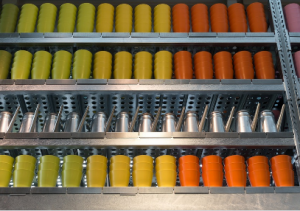
Display flyer and business cards Give it the buyer, too!
Present your products attractive and clearly arranged
Booth maintained properly
Tough market tents with a roof and side panels (outdoor)
Choose (metal)-shelves as a plug system → smooth set-up and dismantling
Practical and stackable (plastic)-boxes with covers for a fast removal of the goods by bad weather
Payment methods: not only cash, provide as well EC-card payment, for example with SumUp, iZettle, paypal, etc.
Standardized set-up → each product has a fix place → better overview for yourself
Choose plastic panels, wood, glass, etc. maybe use tablecloths, according to consistency
Discover the market booth from a distance:
Fix a banner with your logo
Use booth materials, appropriate to your products/image
The result should be a coherent picture
Written applications (very often as a pre-specified application form with a smart curriculum vitae)
Usual are 3 photos of your work + 1 photo of your booth (Use good quality!)
Consider the application/registration deadline → very often 2-3 month in advance!
Withdrawal is possible → Attention: Percentage must be paid
Booth fee: Usually calculated per serial meter + basic charge + costs for the connection for power supply
Selection process through a jury
Withdrawal is possible (Read the terms and conditions!)
Read in advance the rights for participation!
Range of goods: self-made ceramics only!
Booth: name label must be available
Pay attention to the set-up and dismantling times
Please note: Every market has its own market regulations/conditions of participation. Please read it beforehand!
Further information you can find here:
Websites are usually the business card of their owner. It should give visitors a comprehensive view of activities, products or services and arouse their interest in the next event (purchase, more information, contacting, participation in the event, etc.). Their work will take a lot of time, but it is worth it. There is no need to create large pages with professional elements. There are several free online tools to help anyone create a website. Of course, it is possible to order the company that creates the site for both visual and content pages. However, it is important to choose quality content (text and images / videos) that captures, explains everything important and is regularly updated.
An overview of information in one place
The existence of free online web design tools
Constant updating is necessary to ensure the credibility of the site
High costs of creating a professional website in the case of an external company
Low – Medium – High
How to set up a Personal Webpage by myself?
Free Website Builders
Website builders have become powerful tools. They mainly focus on standard websites, both with or without a blog or other functions. Most of them also let you create an online-shop in an intuitive and visual way. One of the advantages is the one-stop-shop concept – hosting, domain, and website editor all from the same provider. They are also easy-to-use tools. You do not need to install any software on your computer!
Creating a website with a website builder usually entails the following steps:
Sign up for either a free or a trial account (however this should not be the permanent solution, the most provider’s costs between 15-40 Euros per month)
Choose a design you like
Customize the content on your website
Choose your hosting provider: there are a few providers on the market, just search via a search engine machine and get started. Each provider has its own advantages and disadvantages. Simply, hosting is where your websites lives. Most web hosting companies will help you pick a hosting plan and walk you through the entire set-up. One thing to note is that when you buy your domain name, the same companies usually offer web hosting services as well. So, if you prefer convenience, it is easier to use the same provider for both.
Choose a domain name: e.g. www.pretty-ceramics.eu or ceramics-max-mustermann.com. You can buy your domain at a few different domain registrars. Most should cost between 15–30 EUR per year. Try using .com or .eu extension if possible. The extension .com or .eu are good to use, if you want to sell your products in the whole EU. If you just want to sell your products in your local environment, you can use the company shortcut like .de for Germany.
You are creating a website for a reason. Before you start building, think about your goals: who is the target audience, what do they need etc. (set up a Marketing plan, see other section).
You want to:
Attracting new customers?
Offering an online-shop? That means sell products online?
Answering questions to your products?
Writing a blog about your work?
Give information about your business or local shop?
Show and promote your work?
Organize your website structure: Everything about your website, including how the pages are organized, the design and copy, should all work to achieve your goals, see questions above. Start by figuring out all the pages that you will need and then deciding which pages will go on your main navigation and which can live one level below. The more pages you have, the more complicated your site will be! For the start, limit the number of pages and focus on the ‘must-have pages’ first. The most relevant and most visited pages that every website should have is a homepage, products you offer (if you have a wide range of products, limit it on your website!), about page, which markets you visit, contact page, which other services you offer. See below, this is just an example. Please note: just set-up the pages which are relevant for your business!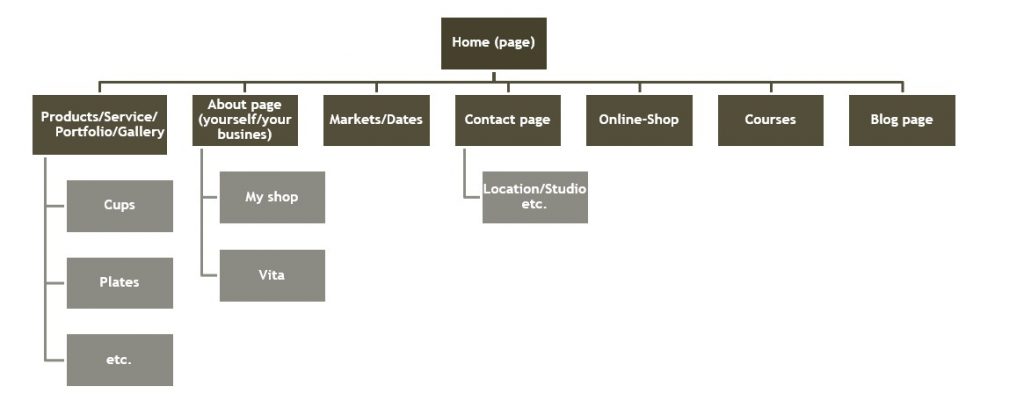 But depending on what your website needs, you can always expand afterwards. Once you have your pages, develop a structure that makes the most sense to help people find what they are looking for. Tip: Get inspired by other websites! Look on websites you also like to visit. Also get inspired by other creatives and ceramists, but be careful, copy is not the way to behave!
But depending on what your website needs, you can always expand afterwards. Once you have your pages, develop a structure that makes the most sense to help people find what they are looking for. Tip: Get inspired by other websites! Look on websites you also like to visit. Also get inspired by other creatives and ceramists, but be careful, copy is not the way to behave!
Design your website: A lot of the website builders have predesigned layouts and design tools you can choose from. Some of them use drag and drop building options, for others you will need some more knowledge on how to design a webpage. Most of them have forums or you can call a telephone support, where you will find a lot of answers. Think about how you want your brand/products/business to be perceived by the public. Use consistent colours and imagery throughout the site. If you do not have your own images to use, you can find professional-looking photos from various free and paid websites, go to a search engine machine and search for photos, which suit to your website and business. However, in the near future you should fill your website with your own photos of your studio, your products etc.
What are social networks?
It is an umbrella term of a lot of different communication platforms in the internet. Among them e.g. blogs, different networks, wikis, videos, music-sharing-portals etc. These portals serve an exchange with each other regarding information, positions and experiences in different ways.
Who is using social networks?
They become more and more popular, not just the younger generation use it, also the generation for 60+ is going to catch up. You can interchange with each other; you can meet like-minded persons in a network or on such a platform. It is uncomplicated to stay informed about products, articles, videos and photos and to stay tuned on the latest trends!
Why should I use social media?
Social media marketing is the use of social media platforms to connect with your audience to build your brand or your product(s), increase sales and drive website traffic. This involves publishing great content on your social media profiles, listening to and engaging your followers, analysing your results (statistics) and running social media advertisements. So social media is a platform, where you can make marketing and advertisement for your products for free!
What should be my focus?
Before you start Set objectives:
Which targets I am going to follow with social networks?
Which target groups I would like to reach?
With which content I am going to reach the target groups?
Which social networks are suitable for me? (different platforms available)
Do I need technical or regards the content support with the implementation?
Please see here a marketing plan for supporting your targets:
Marketingplan-/strategy: To get an overview, which marketing elements have priority for yourself, it would be best to set-up a marketing plan.
| Marketing Plan | Notes: |
|---|---|
Which mission I am following with Marketing?
|
|
| Describe, identify your target group: (in full sentences) On the basis of needs and wishes. Example: My target group are parents with children, as I produce cutlery for children. The group of buyers are between 20 and 40 years. As well as grandparents between 50 and 70 years. They are requesting for dishes which are appropriate for children, have a modern design…. | |
Identifying your group of buyers
|
|
Which kind of products I am offering?
|
|
What is my Unique Selling Proposition (USP)?
|
|
Competitor analysis
|
|
My strengths in the market
|
|
My weaknesses in the market
|
|
Marketing-Budget
|
|
Previous Marketing and sales activities
|
|
Which marketing channels and actions would be suitable for me?
• Start with Social Media?
• Traditional Marketing?
• Start with an Online-Shop?
• Direct Marketing?
|
How should I use social networks?
Providing potential buyers with content they find valuable and want to share across their social networks. Social media shares of content, videos, and images result in increased visibility, traffic and relevancy in search results within social media networks as well as search engines. This is why social networks influence the Search Engine Optimization (SEO), to become more traffic e.g. on your website etc. This is an effective way to reduces marketing spends, as social media is free of charge.
How to create a Social Network with an own Business profile/Brand Page?
Such Pages help companies, brands, organizations and public figures share their news and connect with people. As with profiles, Pages can be customized with news, events and more. People who like or follow a Page can receive updates in the news section.
To create a Page:
Sign up to a new account:
Go to the social network platform provider. Select the type of page you want to create: business/brand or community/public figure (differs of each platform provider). Click the Get Started button for your option. Enter your business information, like page name. Here you can use your commonly used business name, people are likely to search for when trying to find your business.
Choose your category type:
Type a word or two that describes your business and the platform will suggest some options. Choose the one your customers are most likely to think of when they think about your business. Once you choose your category, the box will expand to ask for a few further details, like your address and phone number. You can choose whether to make this information public, or to show only your city and state. Note that doing so indicates your acceptance of the social network platform, groups and events policies, so you might want to check those out before you proceed.
Add Pictures
Upload profile and cover images for your social network platform page. It is important to create a good visual first impression, so choose wisely here.
Profile image – this image accompanies your business name in search results and when you interact with users. It also appears on the top left of your social network platform page. Your social network platform profile picture displays at around 170 x 170 pixels on desktop and around 128 x 128 pixels on mobile. It will be cropped to a circle, so do not put any critical details in the corners. Once you have chosen a great photo, click Upload Profile Picture.
Cover image – the most prominent image on your platform business page. This image should capture the essence of your brand and convey your brand personality. It will display at around 820 x 312 pixels on desktop or around 640 x 360 pixels on mobile. The image must be at least 400 pixels wide and 150 pixels tall, but the recommended size to upload is around 720 x 315 pixels. Once you have selected an appropriate image, click Upload a Cover Photo.
Here is a pro tip: You can even upload a cover video or feature a slideshow of images! For more information and fun ideas.
Create your username
Your username should be your company name. You want it to be easy to type and easy to remember. Click Create Page @Username in the left menu to set up your vanity URL.
Click Create Username when you are done. A box will pop up showing you the links people can use to connect with your business on the social network platform.
Add your business details
Fill out all of the fields in your Social Network Page’s About section at the beginning. As the social networks are often the very first place a (potential) customer goes to get information about you, having it all there is important. To start filling out your business details, click Edit Page Info. From this screen, you can share all the important information about your business.
Description
This short description appears in search results. It should be just a couple of sentences, so there is no need to get too elaborate here. Just describe which kind of products/service you offer.
Categories
Here you will see the category you entered in Step 1. If you like, you can add additional categories here to make sure the social network platform shows your page to all the right people.
Contact
Add all the contact details you want to make public, including your phone number, website, email, online-shop etc.
Location
If you have a physical shop, check to make sure that your location is marked correctly on the map.
Hours
If your business is open to the public during specific hours, enter those here. This information appears in search results and is very useful for (potential) customers.
Extra options
If relevant, enter your imprint (legal notice), price range, and privacy policy link. An imprint is a legal statement of ownership, and it is generally only required in some European countries, but please be aware every country has its own policies on it. Get familiar with it!
Click Save Changes under each section to implement your changes.
Tell your story
There is a section of your social network platform for business page where you can add a longer description of your business. To access it, click See more in the left menu, then click About, and then click Our Story on the right-hand side.
In this section, you can add a detailed description of what your business offers customers and why they should Like or Follow your Page. This is a great place to set expectations. Enter a headline and text for your story, and then upload a relevant photo. When you are finished, click Publish.
Create your first post
Before you start inviting people to like your social network page for your business, you should post some valuable content. You can create some of your own posts. For sure, you have photos/videos of your work for sharing!
You could also create a specific type of post like an event (open door day in your pottery) or product offer—just click one of the options in the Create box at the top of your page.
Publish your page and invite an audience
Your social network business page now represents a robust online presence that will make potential customers, fans and followers feel comfortable interacting with you. Go to Publish Page button in the left-hand menu.
Start by inviting your existing social network friends to like your page. Also ask established customers to like your page and follow you. Use your other channels, like your website, to promote it. Add “follow us” logos on your promotional materials and email signature.
How to promote your site?
Social network platforms are free platforms, but you can always reach more people with easy-to-make promotions and featured posts. These posts are combined with a small expense. If you want to reach an audience beyond the people who have liked your page, you can highlight a post or promote the page.
Make your company known to a wider audience
When you highlight a post or promote your page, you select the audience you want to make it visible to. Choose people who have “liked” your page, extend reach to their
friends or select a new audience.
Set your budget
You control the expense of a featured post or promotion – the platform will never charge you more than the budget you select. The budget is the daily price you will pay for promoting a post. Depending on the audience and budget you choose, there is a chance that you will hit the maximum budget amount every day.
How to create a boosted post?
Go to your social network page.
Find the post you want to boost.
Select Boost Post. You can find it in the bottom right-hand corner of your post. …
Fill in the details for your ad. …
When you have finished, select Boost.
How do I promote my social network page?
Go to your business page and select promote in the left column.
Choose a goal. To drive traffic to your website, select the Get More Website Visitors promotion.
Choose your Ad Creative.
Create your audience.
Set your budget.
Set the duration.
How to create a Social Network Platform specialised on pictures and videos with a Business Profile?
People come to such a platform to be inspired and discover things they care about, and that includes content from brands and businesses:
Around 60% of people say they discover new products on such platforms
Around 200 Million+ followers visit at least one Business Profile daily
Around 80% Increase in time spent watching video on such platforms
Around 1/3 of the most viewed stories are from businesses
Download the application and create an account
Download the social network platform specialised on picture and video application. It is better to download this application on your mobile phone, as it is easier to use. Once the application is installed on your mobile phone, tap to open it. Tap Sign Up, then enter your email address and tap next, or tap log in to your social network platform to sign up with your account (if you have an existing social media account on another platform). Choose a username that clearly represents your business, like your business’ name. Add a profile photo (photo of your work or your logo would be suitable), a biography (small sentences about your business: like handmade ceramics, offers courses, online-shop etc.) and a link to your website.
Set up a free business profile
Within the app, find Settings, and then scroll down to switch to Business Account (a business account has more features for business use). Once you have a business account, you can add in pertinent business information like store hours, business address or a phone number (you are not forced to add it). Create a Business Profile. Note: Your business must have a another social network account to switch to a business profile.
Post and #hashtags
The best practice case is to have a photo or two posted to your account before you start following people. There is not much incentive for people to follow an account with no content. Find a couple of photos of your products you think would be shareworthy.
Keep your caption brief and use appropriate hashtags. Hashtags help to find millions of photos, and in turn, your content can be easier found. Also, keep the hashtags to a reasonable number, around 20 not more! Followers do not want to be spammed with dozens of hashtags per post.
Example: The unique tactility of ceramic material and the many steps involved in the process make it easy to show with vivid clarity how beautiful many moments are in making anything out of clay. As a way to promote ceramics and pots on this platform, try and pay particular attention to parts of the process that will never be seen in the final piece. The corkscrew of trimmed clay, the viscous splash of slip, the gear-like shadow of a scalloped plate edge as it rotates on the wheel.
Follow people and get social!
By this point you have a complete profile, a couple of posts shared, and now it is time to start following people so they start following you. From your profile page, go to the options page (gear in the upper right corner) and choose Discover People.
You can connect different social networks with each other and your address book. If you have got past clients and connections stored on your phone, you will be able to see their accounts. Spread the worth to your customers, that you have a social media account.
As you post more to the platform and follow more people, you can check your notifications page (heart icon) to see who has liked your photos, started following you, left a comment, or mentioned you in a post.
Tip: You have chosen your prefered marketing activites? Take it down in a clear way and check it regularly.
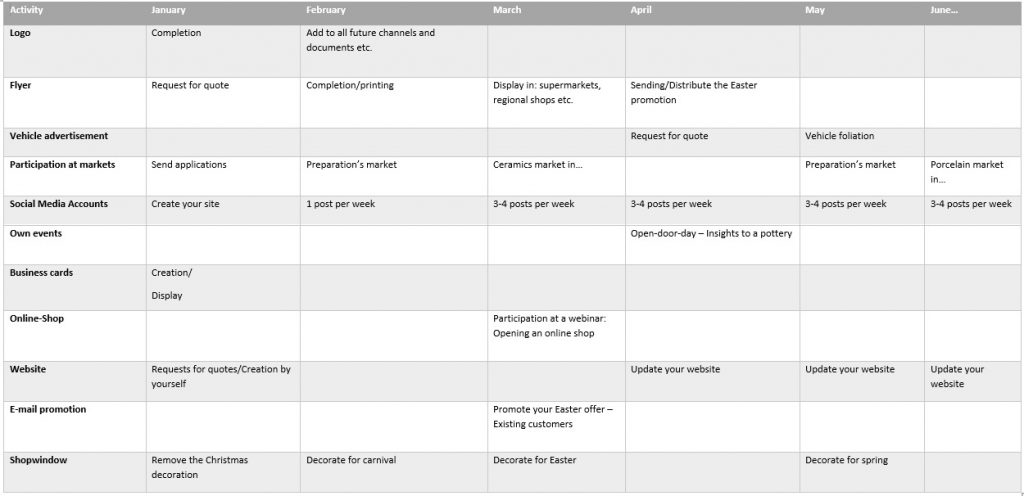
A press release is a more comprehensive text message addressed to the media, which is issued when something important (events or facts) needs to be communicated to the public.
Subsequent distribution of the press release to various news channels should ensure the preparation of articles and placement on news servers or printed sheets.
The report should contain interesting information that is so interesting that it arouses interest in further publication.
Relatively large intervention
Very low costs
Imprint only in case of interesting content of the message
Brochures are used to display the product portfolio, presentation of production. It is advisable to have them as a demonstration of production in case it is not possible to show the products to the customer live or electronically.
Overview of products in one place without the need for a physical visit to the factory / store
High costs for processing and printing quality representative brochures
High
Leaflets are a suitable tool if you want to draw attention to yourself in everyday life, in your surroundings (not virtually, but the electronic version of the leaflets can also be used for online sharing and distribution), e.g. in shops, schools, public places, at various events and events. You can distribute them either in person or leave them on places for disassembly for those interested.
The leaflet should contain simple text clearly expressing what interesting you are offering, links to you (phone, website, social networks, or address), to be attractive to look at. There are a number of free tools where flyers can be created (e.g. Canva) on your own.
Leaflets are no longer a key tool in today’s, but they can serve well as a support tool, for example, in the presentation or sale of your production (markets).
The leaflet will also hit a group of people who cannot be reached digitally
Not very used tool
Less intervention
It is necessary to invent engaging content and visuals
You do not need to send out flyers in printed format, it always costs a lot more money than to distribute it via e-mail attachments, in social networks or WhatsApp etc.
Campaigns (like for Christmas, Easter etc.)
Open-door-days
For display in different institutions etc.
Discount campaigns
Invitations for Markets/Events
Vouchers

Templates free of charge, photos, graphics, etc.
Source: stockata.de
Store opening or notifications for events:
Display flyers etc. in supermarkets (high frequented location!)
Display flyers etc. in different stores: like cafés, regional farm shops, museums, hair stylist etc.
Cooperation with other stores: like glass manufacturers, stoneware production, etc.
Advertising on the TV, which is usually in the form of short spots that promote a particular product or service.
An effective and fast way to reach the large target circle of people
High costs
More suitable for larger companies
High
Paid advertising via radio, which is focuses only on listening.
The possibility of regional targeting
Possibility of targeting to specific groups of people
“Sound only” (people often listen to the radio passively, for example as a backdrop at work)
Low efficiency and memorability
Low – Medium – High
The chance to get to the attention of a large number of people is a report in the news (television or radio). Especially when organizing an interesting event or a very original / innovative / shocking or, on the contrary, a traditional product.
As with participating in a television program, it is often necessary to have “acquaintances” who will give you a production tip and reportage. It is easier to reach the local television / radio, which, however, does not have such an intervention as the national one.
Great intervention at zero cost
Constant demand for news, originalities in the news.
It is necessary to have acquaintances for recommendations or a very original / innovative / shocking product that will be so interesting that it will be advantageous to report on it
For Free
Regional radio and TV-programs broadcast advertisement for your region. You can promote your shop or can create a post for it. The costs are very different, in Germany it is for the radio between 300-500 Euros and for the TV it starts with around 4.000 Euros, ask your local broadcast station.
Establishing your own studio/shop is possible for all manufacturers who have enough products for sale and are able to constantly supply products to the store.
Own space
Independence
High costs of establishment
Equipment and operation
Often difficult legislative conditions
Closure of stone shops during a pandemic
High
The costs a lot depends on the space (own x rented)
Direct (personal) sales out of studio/shop. Offering own products to customers for their subsequent sale, sales through a sales representative to customers at their home or in their office.
Direct contact with customers
Building relationships with customers
Immediate feedback
Time consuming for preparation and implementation
High costs
Medium
The goal of the event that you organize is to create a strong experience in the customer, which will lead to the purchase of your product or service. Thanks to event marketing, you can communicate directly with your customers and customers will perceive this message in real time. So event marketing takes advantage of the fact that people best remember what they actually experience.
When I organize an event, I can easily attract and reach new customers
Building good relationships with business partners
Involve all five senses at once
More time consuming
Low – Medium
Emailing is the targeted sending of commercial and non-commercial messages to a precisely defined list of e-mail addresses with the consent of the recipients. By sending regular e-mails, the company keeps its customers aware and builds its brand.
The basis is the engaging subject of the email and a concise but clear message in the body of the email that invites the addressee to some type of action (buy, look, go to).
A simple and inexpensive communication tool for an already established customer / tracker base
Necessity to have a list of email addresses incl. consents to the sending of newsletters, offers, etc.
Frequent sending causes the e-mail to be automatically spammed or can be annoying and end up in the trash without being read
For free
You sold a product recently and sent out an order confirmation via mail use this action to advertise for special events, like discount campaigns, special offers for Christmas, markets, open door days etc.
This is low effort for customer care/customer acquisition. Generate a monthly e-mail newsletter to all existing customers for example to “what is new in your product range”.
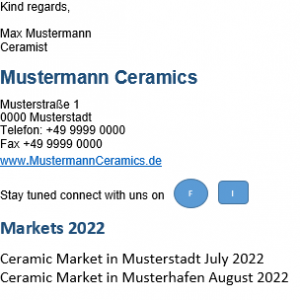
Newsletter per e-mail:
You are planning to release a new product or design? Or you would like to advise something to your customer base? Write a newsletter! You can define by yourself, how often you will send it out. It may be good to send it monthly, quarterly- or half-a-year. Not too often! You could scare your customers off, if you overload them. Write some nicely words in it and make some advertisement for your products, make a link to your website and your online-shop. To be able to send out a newsletter, it would be best to have a customer database with e-mail addresses. (Read below create a „Customer database “)
Create a customer database:
Store addresses, e-mail addresses and notes for example birthdays to send out birthday wishes or newsletter programs to your existing customers. Request for customer’s satisfaction after an order. Stay present and remain in discussions with each other. You can create a customer database with Excel or Access or you can use a special software, which you may have to buy, you can provide excellent customer care.
Participation in events for the general public (for example, various festivities organized by the city, region) is desirable for a non-violent presentation of their own activities. Thanks to them, it is possible to acquire new customers, build relationships with them, establish contacts both with customers and with other actors involved in the event (organizers, competitors, subcontractors, etc.).
There is no need to create your own event, which is time and money consuming
Low costs
Establishing / strengthening contacts
Joint marketing of the event
Low
Exhibiting products in the showcase, or gluing your own showcase with attractive offers is a form of permanent advertising encouraging passers – by to buy. An expert can be arranged for the decoration and the correct advertising function of the showcase. The shop window needs to be changed at regular intervals so that the customer is constantly in sight of new products that will entice them to buy.
Simple and effective long-term advertising with low costs
The showcase needs to be changed at regular intervals
For free
It is very easy to create a company account on the most used search engine. It is visible on the side of the application window (on a PC) or when scrolling (on a mobile phone). It creates a simple and clear picture of the company / entrepreneur. Customer can easily go directly to your own website, call or look at a location map or photos. The profile also
includes reviews from customers or their photos. It is desirable to always make this entry.
A simple and clear tool on the popular search engine, which is free.
Search engines usually wants to confirm the registration in the form of a code sent by regular mail, which extends the registration by a few days
With any change, it is necessary to think about updating the data (phone number, address, website, etc.) so that everything remains current and credible
Visible only when a specific request is entered
For free
If you just want to say where your business is and how to get in contact with you or you just want to say where is your local shop, it would be sufficient to have a one-pager website:
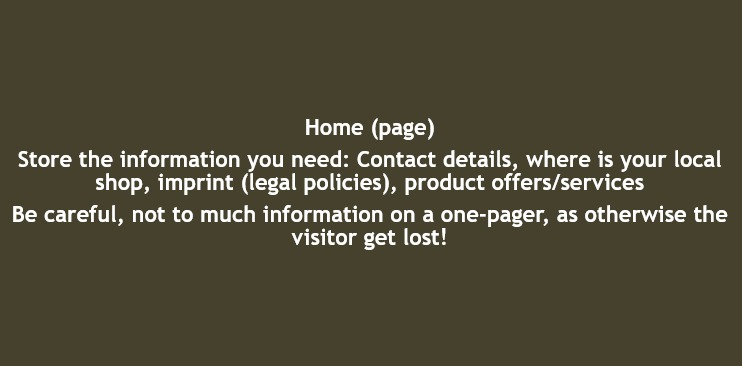
A One-Pager website you can set-up really fast and free of charge (or to a low budget). Be sure that you use a provider, which is specialised to a One-Pager website.
You can have a “bigger” website with:
A homepage: Start picture, logo etc.
Your product range
About page with your personal information and your vita
Market site: which markets you are going to visit
Course offer: if you offer ceramic courses
Blog page: if you are going to write more about your work and would like that the customers can look behind the scenes
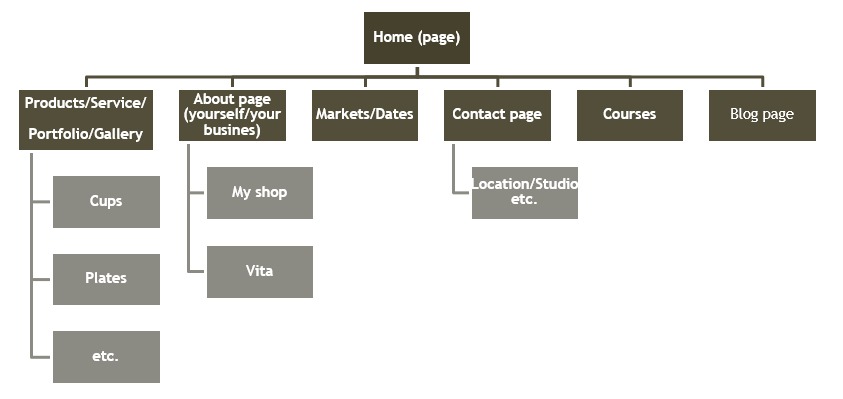
If you almost or only sell your products via an online-shop, you should lead your focus on your website on your online-shop. The online-shop should be a part of your homepage or even there should be a link on your homepage to the online-shop. The whole website need to be focused on the online-shop. If you are selling also on other sale platforms, you should mention and link it.
